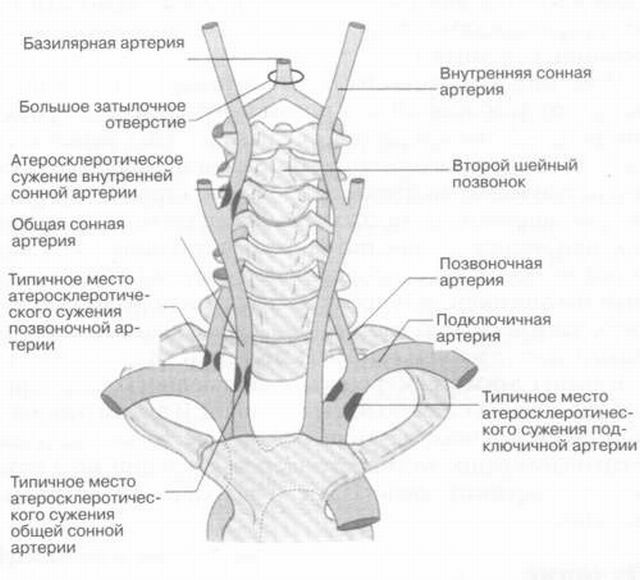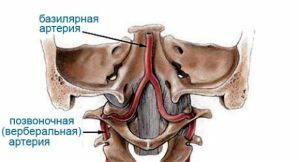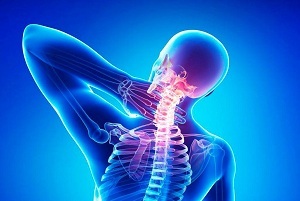 In the lower part of the brain stem is the basilar artery, which is a collection of vertebral arteries.
In the lower part of the brain stem is the basilar artery, which is a collection of vertebral arteries.
The basilar artery provides blood supply to the brainstem, the occipital hemisphere and the cerebellum, and when the blood flow in this artery( and at the same time, in the vertebral arteries) decreases, the person may have dizziness, speech problems, tinnitus, visual impairment and even stroke. This disease is called vertebro-basilar insufficiency( VBN) or vertebrobasilar syndrome.

Contents
- Congenital and acquired disease: causes of
- Other causes and risk factors
- Against the background of which diseases
- is manifested Osteochondrosis, as a provoker of
- syndrome WDV syndrome in children
- Features of clinical picture
- Diagnosis of
- Provision of medical care
Congenital and acquired illness:reasons
It is worth noting that VBI can be both congenital and acquired. Causes of the disease can be different. If we talk about the congenital vertebro syndrome of basilar insufficiency, then the causes are fetal injuries during pregnancy, premature birth and possible other traumatic situations in which the vessels of the fetus could be damaged.
As for the acquired form of the syndrome, it is based on diseases related to circulatory disorders and changes in the state of the vascular system in the brain region.
The most frequently acquired vertebrobasilar insufficiency arises under the influence of the following diseases:
- diabetes mellitus;
- major artery thrombosis;
- vertebral artery thrombosis;
- spine trauma;
- vascular wall disease( eg, vasculitis, arthritis);
- osteochondrosis of the cervical spine;
- Hughes-Stowin syndrome, etc.

Vertebrobasilar pool
Other causes and risk factors
The following reasons for the occurrence of VBI are currently being considered:
- , the destruction of the main vessels of the subclavian and nameless arteries, the extracranial vertebral part;
- microangiopathy against diabetes mellitus, arterial hypertension;
- features of the structure of the vascular bed( from birth): aplasia of vertebral arteries or their abnormal retreat, pathological tortuosity;
- trauma to the cervical vertebra;
- compression of arteries with cervical vertebrae;
- antiphospholipid syndrome.
Against the background of which diseases the syndrome of
is manifested There are many factors that can contribute to the development of vertebro-basilar syndrome. In people of middle and young age, this disease can manifest itself as a result of squeezing the vertebral arteries with bone growths - osteophytes. 
The probable cause of VBI development may be the deformation of the vertebral artery canal or its underdevelopment( hypoplasia).Painful spasm of the vertebral artery also plays an important role in the development of this syndrome, as well as developmental anomalies( for example, an additional cervical rib).
Older people often have atherosclerosis, which may result in the development of vertebro basilar insufficiency syndrome. Atherosclerosis, atherosclerotic plaques form in the artery lumen. As a result, the lumen of the arteries narrows, because of which the blood flow in their pool decreases.
In addition, in the place of divergence of plaques, thrombi form, and they further narrow the arteries' lumen. Moreover, a thrombus can generally clog the artery, which naturally will disturb the blood flow. In this case, a thrombus can somewhere in the heart cavity and migrate to the vertebrobasilar basin with blood flow. This process is called "thromboembolism."
Quite rarely, the cause of the development of vertebro-basilar insufficiency is the stratification of the wall of the vertebral artery. This occurs as a result of a neck injury or during manual therapy( with rough medical manipulations).
Actually, the causes and ways of development of this ailment are many, and it is almost impossible to describe them all.
Vertebro basilar insufficiency also often develops in the background of cervical osteochondrosis.
Osteochondrosis, as a provoker of the
 syndrome One of the causes of VBI is cervical osteochondrosis. Because of poor circulation in the spine, the brain suffers, and on this soil a person feels severe headaches, dizziness.
syndrome One of the causes of VBI is cervical osteochondrosis. Because of poor circulation in the spine, the brain suffers, and on this soil a person feels severe headaches, dizziness.
Along with this, a person can vomit, the body becomes weak enough that even walking is hardly given. If, when squeezing the arteries of the spine, a person feels pain or just becomes worse, then first of all it speaks about the development of VBN against the background of osteochondrosis.
All of the above symptoms of vertebrobasilar insufficiency are the result of impaired blood flow to the brain regions: the cerebellum, brainstem, and the visual cortex of the occipital part. This is provoked by osteochondrosis. Its development can also be a cause of spasm of the carotid and vertebral arteries.
As a result, the blood supply to parts of the brain is impaired and, as a result, the head is spinning. There may also be other symptoms: numbness of the tongue, wobbling with motion.
Syndrome of VBN in children
Despite the fact that this disease previously belonged to the middle and elderly age, it often manifests itself in children. It is statistically determined that the syndrome can appear in children of such ages: 3-4 years, 7-10, 12-14 years. Most often, the disease occurs due to congenital anomalies of the vertebral and basilar arteries. But other risk factors are also not excluded, in particular, damage to the immature pediatric spine in case of falling and even doing sports.
There are definite signs in children on which it is possible to determine or at least suspect the development of vertebrobasilar insufficiency:
- violation of the child's posture;
- the child quickly gets tired, his drowsiness rises;
- the child suffers heavily stuffiness - sometimes even to nausea or fainting;
- the child is sitting in an uncomfortable position( skossobochivshis).
Involvement of children with VBN can even have illnesses that children have had in early childhood, for example, encephalopathy.
Features of the clinical picture
All the symptoms of the disease are quite eloquent. Manifestations of the disease can affect most systems and organs. This is due to the fact that the pool of vertebro-basilar vessels provides various functional zones enriched with oxygen in the blood. 
The main symptom of the disease is dizziness. This is the evidence of a violation of the vestibular apparatus. Very often dizziness is accompanied by noise in the organs of hearing, vomiting and nausea. But this happens in neglected situations.
The duration of such attacks is very subjective. Speaking of noise, information is contradictory. Some say about an unpleasant whistle, others - about a crack, like a fire and the noise of the surf. Natural reflexes and the speech center also suffer violations of vertebro-basilar insufficiency. Speech becomes monotonous almost not perceived. The swallowing reflex can completely disappear. Such a manifestation must instill a significant concern for health.
It is very likely that vision deterioration, accompanied by a violation of sharpness, a sense of rippling, bright colors and large objects cease to be perceived near. Drop-attacks are becoming more frequent. Without a medical response, all manifestations are increasing and even intensifying.
The first 5 years of vertebro basilar insufficiency development the patient will be inclined to stroke, ischemic attacks, after which the person's life will flow in a completely different rhythm.
All symptoms of the affected organism will progress in groups, significantly reducing the quality and standard of living. They can arise and disappear unexpectedly. Even a mild form of the disease gives the patient acute discomfort. The heavy stage completely rivets to the bed. The period of a severe stage can last indefinitely.
Diagnosis of
It is very problematic to make an accurate diagnosis, this is due to the fact that the symptoms of the syndrome of VBN do not differ with any specific indicators from a number of other diseases. The diagnosis is based on a thorough study of the history of the disease and patients' complaints.
 Complete instrumental and physical examination is carried out. The main method of examination is ultrasound dopplerography. It is necessary to assess the rate of arterial blood flow to the neck and head. The method is completely painless. Arteries of the spine are also subject to detailed examination, as they are often also affected.
Complete instrumental and physical examination is carried out. The main method of examination is ultrasound dopplerography. It is necessary to assess the rate of arterial blood flow to the neck and head. The method is completely painless. Arteries of the spine are also subject to detailed examination, as they are often also affected.
To determine the causes of the onset of the disease, CT and MRI are prescribed. But these studies are not very informative, since the small size of arteries is very poorly visualized in the image.
Angiography is also common. The method is based on the investigation of the diameter and general condition of the internal arterial walls. But this method has certain contraindications and the risk of complications. Only clearly defined indications can force a specialist to carry out this method.
Medical care
At the initial stage of the disease development, treatment is performed on an outpatient basis, when there is acute acute vertebrobasis insufficiency, the patient is immediately transferred to a hospital for careful observation and prevention of stroke risk.
The most commonly prescribed treatment is physiotherapy in combination with medication. Certain forms of VBI can not be treated with any drugs. It is very important to establish all the reasons as soon as possible. Treatment is prescribed strictly-individually to each patient.
When vertebrobasilar syndrome is diagnosed for therapy, such drugs are used:
- Vasodilators prevent occlusions. It is recommended to start taking such medications in the spring or autumn period. The dosage gradually increases. In the absence of changes, prescribe drugs similar in effect in the complex.
- Drugs that reduce clotting prevent the appearance of thrombi. Very popular is acetylsalicylic acid. In a day it should be consumed in a volume of at least 50 mg. Patients with gastrointestinal problems use
 acid should be careful. There is a possibility of gastric hemorrhage. Aspirin can be replaced with Ticlopidine and Dipyridamole.
acid should be careful. There is a possibility of gastric hemorrhage. Aspirin can be replaced with Ticlopidine and Dipyridamole. - Nootropic and metabolic products of improve brain function: among others Glycine, Cerebrolysin, Semax, Piracetam, Actovegin are prescribed.
- Drugs for pressure regulation .
The following methods of treatment and rehabilitation are used: massage, medical gymnastics, magnetotherapy, cervical corset, hirudotherapy, acupuncture, etc.
Surgical treatment is rarely prescribed. It is performed to improve blood circulation in the vertebral and basilar arteries. A very common method is angioplasty, which prevents the arterial lumen from clogging with a special stent. Microdiscectomy stabilizes the spine.
Folk remedies are used only in combination with medications. Such means include garlic, vitamin C, horse chestnut, hawthorn, mint, yarrow, birch buds, immortelle, etc.
It is important to treat diseases that provoked vertebro-basilar insufficiency. Attentively it is necessary to treat the diet( to abandon all sausages, white bread, sour / spicy, canned food, fatty and roast), minimize the amount of salt used, overcome bad habits, control pressure, pay attention to moderate stresses and walks.
If possible, you should go swimming. It is very important not to sit for a long time in uncomfortable positions. Maximally protect yourself from stressful situations. A mattress, pillow and bed should be as comfortable as possible.


